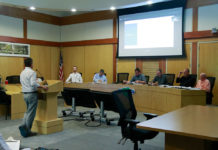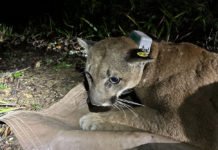Controversy over the fate of the animals currently in the program
Santa Rosa Junior College’s Dean of Agriculture/Natural Resources and Culinary Arts Benjamin Goldstein is excited about the future of the programs at the college’s flagship location, Shone Farm. But, he admits that when controversy exploded on social media last week about the future of the programs, facility and animals that call it home, he was a bit blindsided and had perhaps underestimated the needs of the current Shone Farm community.
“The social media world has an ability to take off in many directions. I’ll own whatever misinformation had to do with my timing or not putting out the (informational letter) widely enough,” he said. “I accept that responsibility and am happy to clarify what our intentions are and how excited we are about it.
“Should we have blasted it out?” he wondered aloud. “Is it something newsworthy? It is now, I guess. Something I’ve learned is how passionate the livestock and equine community is. They care at such a deep level.”
The drama began when current SRJC Equine Science student Becky Shapley posted on Facebook that the school was closing down Shone Farm programs and selling the livestock at auction, including the cattle herd, the sheep herd and the nine elderly horses who have been part of the equine program for more than a decade.
Shapley’s post drew the attention, and ire, of local horse people and other members of the agricultural community. In the equine world, sending horses — especially elderly and in some cases unridable horses — to auction usually carries a connotation of a long, terrible ride to a slaughterhouse in Mexico.
Goldstein quickly attempted to quell the rising tide by going onto social media and posting both a letter about the plans for the future of Shone Farm, and explaining the plans for the animals, which included adoption of the horses, not auction. Shapley and others remain unconvinced.
According to Shapley, she’s been noticing changes in the equine program for about a year and a half, ever since current program coordinator Maxine Freitas took over. Since then, Shapley alleges that classes have been cut, other adjunct professors who had been long time riding and handling instructors have been phased out and their teaching privileges at the facility ended.
“When Maxine Freitas took over as equine director there were big changes, tons of classes being canceled,” Shapley said. “All instructors teaching riding and handling, the adjunct faculty, have not had classes for over a year. (Freitas) was an adjunct faculty member before that, teaching the therapeutic riding class, but ever since she took over, she’s taken over the handling class, which she never used to teach before.”
“There are several instructors that are in the pool, instructors that have taught and are currently active,” Goldstein responded. “Maxine is the most senior of those so she gets priority of assignment and any additional classes, but she’s an adjunct so she has a cap of 67 percent of the courses. Any additional courses go through other instructors. This is not about favorites, it’s completely governed by the faculty association contract about seniority and the load they are entitled to each semester. I don’t think (Shapley) understands, it’s very contractual and there is a little wiggle room, but not a ton.”
However, Goldstein acknowledges that changes have been afoot for some time. “Whenever a new faculty member comes on board and has the opportunity to rethink the direction of their program there are inevitable changes,” he said. “(Freitas and animal science coordinator Amy Housman) have been working with farm manager Leonard Diggs and the previous deans for a couple of years to do some envisioning of what the animal science and equine program could become. My arrival six months ago as the new, and hopefully permanent, dean, gave me the ability for a few months to get the lay of the land and work with the faculty and staff at the farm and the advisory committees for these programs, that was enough for me to feel comfortable in initiating the changes at the farm.”
Those changes, according to Goldstein and a letter signed by all the faculty and staff at Shone Farm, include updating and upgrading the barns and facilities, including pastures and composting facilities, changing and expanding the number and types of species of livestock available for students to work with, increasing the integration between the sustainable agriculture and culinary programs and the livestock programs and expanding and improving the classroom and lab/hands-on offerings.
According to Goldstein, many of these changes have to do with the notion that the future of agriculture — and jobs in the industry — will be based more on things like sustainability, artisanal/heritage offerings and carbon farming, and that the programs need to reflect that.
Among the ideas on the table are adding a dairy goat herd, various poultry flocks and a swine program, all of which could tie into both the sustainability piece, the artisanal piece and the culinary program for things like cheese making and charcuterie.
On the equine side, changing the types of horses the program has available and partnering with other institutions — like the vet program at UC Davis and an equine breeding program being piloted at Feather River College — will, they hope, create students that are more employable and prepared for their future career or scholastic goals.
“The livestock at the farm are there to support the academic programs,” Goldstein said. “The academic programs are animal science and equine science, and so when you want to change things up you are always looking at instructional resources — what do we need and where do we need to go with those resources? That really was the genesis of the changes in the livestock at Shone Farm. We’re reimagining what species we want to teach based on the needs of local industry. What jobs are we preparing students for, both on the livestock and equine side?”
There will be curricular changes, as new programs become part of the “transfer model,” which guarantees community college students who complete the program admission at a California State University. There will still be certificate programs available, though changes may occur to offerings as part of the overlap, according to Goldstein.
“It just came out and we are in the process of adopting it and phasing out our pre-existing animal science degree,” Goldstein said. “There are components we currently don’t have and need to create in order to meet the template. We have most of them, but we need to develop a few new courses and tweak existing curriculum. That process has been a part of (Housman) coming on board — looking at that curriculum and doing a gap analysis with what we offer, and making that part of the changes that we want to make over the next six months to a year.”
But Shapley is unconvinced and laments the loss of what she sees as the fundamentals of the previous program. “I would love to see the equine science program back to what it was, starting with riding and handling,” she said. “Most people want to ride a horse, that’s why they get into it, and once you’re hooked, then you want to go to the classroom classes and learn about farrier work, the science, the nutrition part behind it. That’s what got me started on this.”
The nine horses were placed up for adoption, though since they had been donated originally they were all offered back to their original owners to begin with, and some will return to their previous homes. From there, the school solicited letters of interest from potential adopters on its website — the letters had to be in by Dec. 18.
From there, a committee of Diggs, Houseman, Freitas and Goldstein will go over the letters and make determinations as to the final adopters.
The sheep had been slated for a trip to the auction house, but after an ad on CropMobster, the whole herd found a local home together.
The cattle will remain on the property until late spring, to allow this year’s calves to finish growing, and then a final determination of their placement will be made.
Shapley has plans to adopt one of the horses, Rowdy, but is suspicious of the motives and plans. “To try to move them and find brand new homes in a week? Anybody who cares about a horse wouldn’t say, in one week I’ll find a perfect owner and remove them from their home,” she said.
She’s also suspicious of the renovation plans. “That sounds like a story,” she said. “What are they going to update? I’m not quite sure and not getting an answer on what they are going to do or what they think needs to be done. For them to say they need to get rid of livestock to restructure, that is BS. Why do they need to be moved to do some restructuring? It sounds like it’s the end of an equine program. How do you have one without horses?”
“We are 100 percent committed to bringing back livestock and equine programs in a big, new way,” Goldstein said. “The way the barns and species exist currently aren’t conducive to these new innovations. But, we are not ending the animal science or equine academic programs; they are going to continue even through the renovations. Students will have the opportunity to do their lab work at partnering ranches in Sonoma County, many of which we already take students to on field trips. It will be an enriching, hands-on experience for students, even without livestock at Shone Farm for this period.”
Goldstein says the strategic planning and physical planning will get started in the spring of 2018, and he will be convening several town hall-style community meetings with the local agriculture and equine communities to get input as to the types of things the new programs and facilities should include.
Because there is construction involved, he is unable to give a timeline for completion, but the plan is to move as quickly as possible, though he expects that there will be no hands-on classes at Shone for all of 2018.
“We’ve got great staff and a great property, its time to invest in it,” Goldstein said. “I think this will help with our enrollment challenges, too. It’s already a world-class facility for a community college, and soon it will be a world-class facility, anywhere. It will help us advertise around the state where students are looking for that enriching academic experience. It will be an unparalleled as a learning lab for students.”









